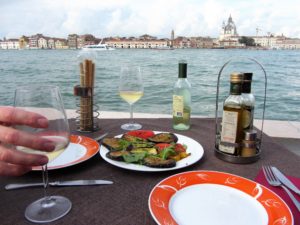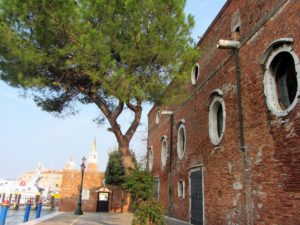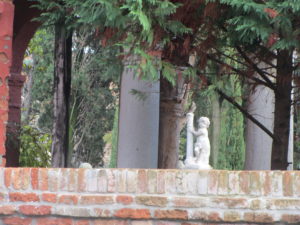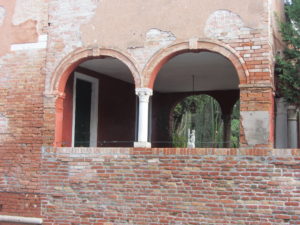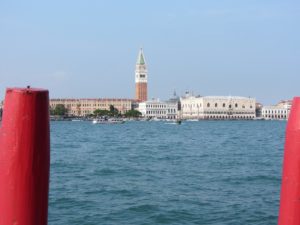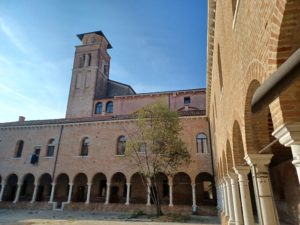When staying in Venice my husband and I like to pop over to Giudecca as although the island is large and the closest one to the main part of Venice it is quiet and less touristy. Historically it was where exiled nobles were sent for punishment but from Renaissance times it was favoured by nobility seeking an indulgent, decadent life; it also had many convents, one being notorious for Casanova’s exploits. Then, in the 19th century, it became the industrial hub of Venice and this continued until the 1950’s by which time industry had declined due to the 2nd World War. Consequently in recent years many of the old industrial buildings have been turned into upmarket hotels, art studios and student housing: for example, at one end the huge Molino Stucky flour mill has been transformed into the Hilton Molino Stucky while at the other end of the island an old granary has been restored as an events location at the Belmond Hotel Cipriani. Giudecca is a place of contrasts: it is still home to the women’s prison, blocks of more recently built apartments for workers and students and scruffy, neglected industrial buildings awaiting renovation but is also the location of the Cipriani, one of the world’s most exclusive hotels, mainly hidden from view and with its gardens and grounds facing south over the lagoon.
I think there are 3 vaporetto stops on Giudecca – all on the side of the Giudecca Canal facing Dorsoduro – and the services that stop there are usually the 4.1 or 2, although we found some changes the last time we visited, probably due to the pandemic. Services also change according to the season so it’s really important to check before travelling and equally important to know which direction you want to go. Also be aware that the numbering can change while you are en route, as happened to us when we reached Piazzale Roma, went to get off because we thought the service stopped there, and then realised it was continuing along the Grand Canal as a different number. Never be frightened to ask the crew members, even in English; I’ve always found them helpful.
One way to see Giudecca is to get off the vaporetto at one end of the island and walk to the furthest stop at the other end, exploring along the way. Zitelli is the stop closest to the Cipriani Hotel and one of the best views of the main part of Venice, chiefly Dorsoduro, can be enjoyed while sitting at a cafe table on the fondamenta looking across the water at the wonderful buildings opposite. The Giudecca Canal used to be the canal along which large cruise ships were pulled by tugs to their moorings at the docks in Venice but they are now banned from entering the port so have to berth on the mainland instead. Near the Zitelli vaporetti stop is the Casa dei Tre Oci, a striking 1913 neo-Gothic building now used as an art gallery and exhibition space but I’ve yet to explore inside: I once read that Elton John owned it or had an apartment there but I don’t know if that was true.
Ever since I read about the Garden of Eden I’ve wanted to find it. Frederick Eden (the great-uncle of Anthony Eden) and his wife Caroline (the sister of Gertude Jekyll) bought six acres of what remained of the garden of the Convent of the Cross, built a villa and designed their own English style garden around it – pergolas covered in roses, paths made of seashells, lawns, fountains, flowering shrubs, many trees and even grazing cows. The rich and famous visited and it was the inspiration for several books, including one by Henry James. Frederick died in 1916 and then, a year before her death in 1928, Caroline sold it to Princess Aspasia Manos, the widow of King Alexander of Greece, who bought it with financial support from her friend Sir James Horlick (of Horlicks malted drink). Aspasia lived there apart from the period of the Greco-Italian war and WW2. Alexandra, her daughter, also lived there with her husband Peter II of Yugoslavia and their only child but he abandoned her and she suffered some traumatic times. Some say she lived there until 1974, others that she died in Eastbourne in 1993 or that she was still living in Venice in 1978. From 1979 until his death it was the home of the Austrian artist, Friedensreich Hundertwasser, who preferred wild vegetation which he allowed to take over the original planting. When he died in 2000 he left it to a foundation but it remains locked and dilapidated although there were plans to renovate it `when funds allow`. As it has been classed as a ‘monumento nationale’ since 1945 there is still hope that it will one day be open to the public. At the end of Fondamenta Croce we crossed a bridge over Rio Croce, turned left at the next opening to the Fondamenta Rio Croce. Facing us across the Rio was a very high wall with a guard house which belonged to what was the men’s prison, then further along the Fondamenta we found it – an iron bridge with locked gates leading to an entrance to the Garden of Eden! The garden is surrounded by high walls and buildings incorporated into the perimeter so all we could see were glimpses of cypress trees and a couple of sculptures.
Returning to the Fondamenta S. Giacomo, a short distance along is the striking white Palladian church of Il Redentore which is a prominent landmark and what most people go to the island to see: there is a charge to go inside but compared with the exterior I thought the interior was slightly disappointing. Il Redentore was commissioned by Venetians in the 1580s in gratitude for surviving a 16th century plague! There is a vaporetto stop at Redentore. The Giudecca Canal is still used by the car ferries heading to and from Venice’s large car park at Tronchetto and all the essential boats that provide services to Venice – the police, customs, rubbish collectors, food deliveries, builders, post office and couriers, like DFL – so there’s always something interesting to see, plus a panoramic backdrop of church domes and campanile. On a hot sunny day I imagine that the buildings lining the Giudecca Canal cast welcome shade but in the autumn and winter the sun only reaches certain areas for a short time so one needs to search out these places for a bit of warmth. Giudecca is not really suitable for people with limited mobility, although it is better than the main part of Venice as there aren’t quite so many canal bridges to get over and there are no crowds.
We then found the entrance to GAD, the Giudecca Art District, so went in to explore, found a restaurant and had lunch there (see separate review). Further on we found the 15th century ex-Convent dei Santi Cosma and Daniano, which is now a centre for artisans, with studios on two levels around the cloisters but we only had time for a quick look and to take some photos of the building, then went back towards the quayside where we found the island’s oldest church, Sant’Eufemia, which faces the Gesuati Church at Zattere opposite. Sant’Eufemia has 9th century origins but the classical columned facade is mostly 18th century. Services are usually conducted by Cappucin monks. We didn’t manage to reach the Fortuny showroom on this occasion as by then I was too tired but I have done a separate review of a previous visit to Fortuny.
